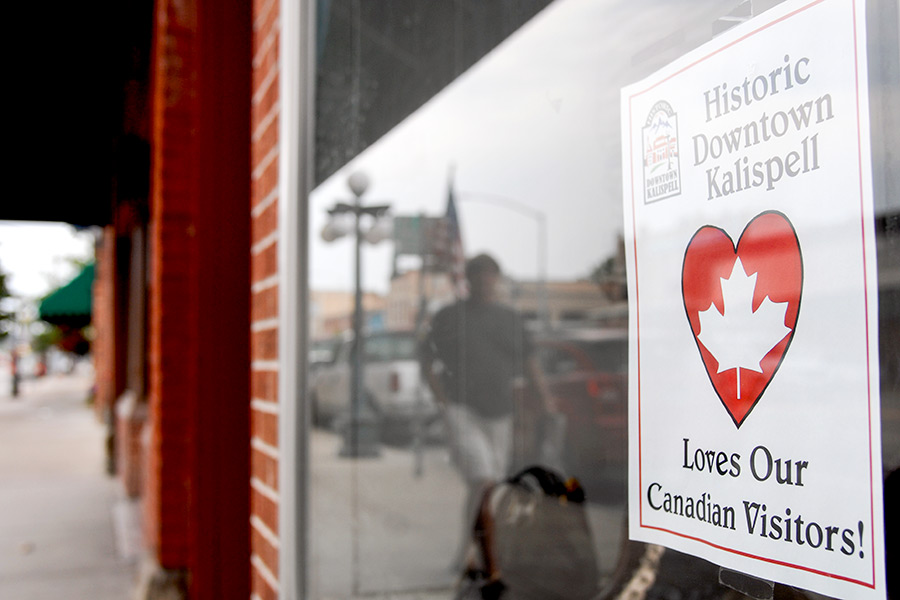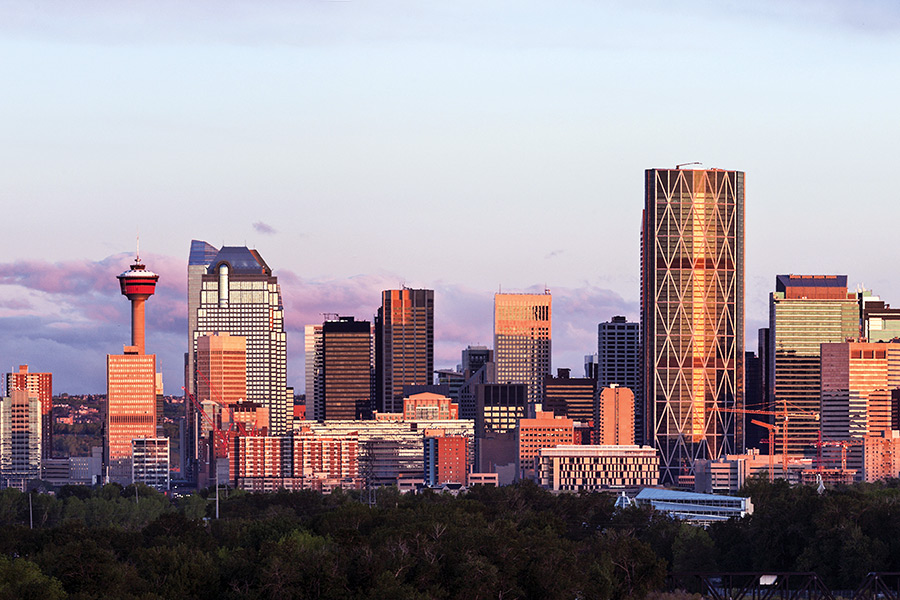Recently, Diane Medler, the director of the Kalispell Convention and Visitor Bureau, received an email from Canada.
A team from Calgary that registered for the upcoming Montana Pond Hockey Classic west of Kalispell needed to back out.
“They said they couldn’t afford to go because the Canadian dollar was so low,” said Medler, who is helping organize the third annual tournament. “They said it would be too hard to make it work.”
After years of cascading visitation and spending from up north, this latest rush of Canadians is subsiding in Northwest Montana.
The economy across the border is in a tumultuous state, plagued by plummeting oil prices and sagging currency that now pales in comparison to the bolstered U.S. dollar. The Canadian dollar, or loonie, fell below 70 cents U.S. last week, 20 cents lower than a year ago and the lowest amount in nearly 13 years. That means a visitor would need $145 in Canadian currency for $100 in Montana.
The top forecaster of Canadian currency last week predicted that the loonie would most likely keep falling to a record low of 59 cents U.S. by the end of the year, marking a dramatic decline from its all-time high of 110 cents in November 2007.
The turbulent relationship between the U.S. and Canadian currencies has a long history and the pendulum seems to swing every decade or two. But as Canadians tighten their budgets amid an economic downturn, the impacts are rippling throughout the local economy, leaving some people anxious and alarmed, particularly in the lodging, real estate and retail industries.
There are reasons to remain optimistic, according to Medler and others, as domestic visitation picks up steam and softens the blow.
But the absence of Canadians is noticeable.

From January through August, there was a 6.3 percent decline in Canadian vehicles entering Montana, according to the latest figures from the University of Montana Institute for Tourism & Recreation Research.
Statewide, Canadians accounted for 14 percent of the total nonresident visitation in 2014. That year there were an estimated 1.54 million Canadian visitors who spent $272 million in Montana, according to ITRR.
The figures for 2015 are still being tallied, but early estimates show both visitation and spending by Canadians were down last year, according to Norma Nickerson, director of the ITRR.
The Flathead Valley has benefited greatly from its neighbors to the north on and off for decades. This most recent surge was especially significant as it buoyed the local economy during the recession. Canadians flocked here in droves, shopping for everything from groceries to vehicles and second homes.
Now the turmoil across the border appears to be tempering that local trend.
“They’re still coming but not in the numbers they were and they’re definitely not spending as much as they used to,” Medler said.
»»» RELATED: As Economy Struggles, a Shift in Canadian Politics
Canadian customers were down roughly 30 percent at Costco this year, according to Warehouse Manager Greg Gillingham. Other local retailers in Kalispell and Whitefish echoed the sentiment.
At Whitefish Mountain Resort, there have still been a noticeable amount of Canadian skiers but fewer of them are lodging at the mountain, according to Nick Polumbus, director of sales and marketing at the resort.
“Our skier visits have been good and there are still a lot of Alberta plates in the parking lot, but we’re way down in our Alberta lodging,” he said. “Maybe they’re staying with friends now or finding a less-expensive place to stay during their ski trip.”
The real estate market is undergoing a similar shift.
There are 1,623 properties in Flathead County owned by someone with a Canadian mailing address, according to Montana Department of Revenue figures. Statewide, there are 3,772 Canadian-owned properties.
In 2012, when the local real estate market was still recovering and the Canadian economy was booming, there were 225 properties in Flathead County purchased by someone living in Canada.
Last year, in contrast, Canadians purchased only 21 local properties.
“I think we will see fewer and fewer buyers, and potentially we’ll see some of the people take that money across the border because it’s advantageous for them to convert it right now,” said Ross Pickert, a longtime local realtor and the president and managing broker for Glacier Sotheby’s International Realty in Whitefish.
“Based on hearsay from different merchants, there has been a tremendous drop-off in activity.”
In the coming months, the local market could see Canadians increasingly selling their homes to capitalize on the stronger U.S. currency, Pickert said.

While all of this may seem concerning for the local tourist-based economy, it is worth noting that Canadians represent only a segment of the valley’s total visitors and another trend has emerged that is keeping overall tourism figures above historical norms.
Domestic travel and spending are both increasing annually, fueled by an improving U.S. economy and low gas prices. Strong tourist destinations across the country are reporting heightened domestic attendance. That includes the Flathead Valley, where the economy is much healthier than a few years ago and its tourism industry has expanded significantly.
Both Glacier National Park and Glacier Park International Airport experienced record years in 2015. An additional 325 hotel rooms are being built in the valley this year.
The local real estate market just experienced its best year in terms of home sales since 2006. The number of sales jumped 11 percent in 2015, despite fewer Canadian purchasers.
The Flathead Valley appears to have established itself as a fortified tourist destination that can withstand fluctuations in specific markets, reflected by the upcoming Pond Hockey tournament. This year’s event is attracting 15 Canadian teams, only one fewer than last year, while there are eight teams from California registered, compared to only one a year ago. Teams from Oregon, Washington, Idaho and even Connecticut are also slated to play. With three weeks left to register, there are 61 teams signed up, the same as last year, and organizers expect the total number will approach 70.
“The word is getting out. There are so many things to experience here and it’s affordable and accessible,” Medler said.
State and local marketing campaigns have picked up steam and proven successful, tapping into large markets such as Chicago for solid domestic visitation.
At Whitefish Mountain Resort, domestic markets such as Washington and Illinois have increased and helped pick up some of the slack from Alberta’s dip, Polumbus said.
»»» RELATED: Cause and Effect of Slumping Oil Prices
In Whitefish, the bed tax collections show 2015 was one of the best years on record in terms of lodging. From January through September, a total of $710,071 was collected, the third highest amount on record since the tax on lodging prices began in 1987. The annual record amount ($807,446) came in 2014 and the second highest total ($771,001) was in 2013, an amount that could be surpassed when the final three months of 2015 are tallied.
Perhaps even more telling, the amount of lodging collections from only July through September in 2015 was larger than the town’s total annual collections from 1988 through 2004.
“This illustrates that although we are currently experiencing a decrease in Canadian visitation, our tourism economy is very robust and our numbers are still not that far off from our record year of 2014, all things considered,” said Dylan Boyle, executive director of the Whitefish Convention and Visitors Bureau, which has teamed up with the Kalispell CVB to focus on domestic markets for visitation.
“We’re in a much better situation than we were before.”
Kalispell also enjoyed one of its busiest years in terms of lodging last year and is expected to surpass $1 million in collections for the third year in a row.
“Frankly, more folks are coming,” Boyle said.
“Domestically we’re getting to be a well-known, premier travel destination, and that’s our mission here, is to continue to grow that domestic market so in these years when Canadian visitation is lower, we’re still bringing other travelers to help offset that.”
